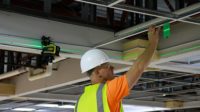In much the same way that GPS and, by extension, machine control have changed the complexion of the construction industry, precision measuring instrumentation is steadily revolutionizing a host of trades and their approach toward their respective businesses. For drywall and framing specialists Gypsum Systems Interiors, that change has manifested itself through the purchase of a robotic total station for use in the layout facet of their projects. The result has been not just a streamlining of onsite production and better quality control, it has also positioned them as key team players once the inevitable adoption of business information modeling occurs in their area.
Alone Again Or
Based in Farmington, New York, about 25 miles southeast of Rochester, Gypsum Systems Interiors has been in operation since 1975. The company is the net result of being spun-off from a similar firm located in nearby Buffalo, according to Kevin Finke, company vice president.
“GSI was actually started by my grandfather who, at the time, worked for a large, union-staffed drywall company in Buffalo,” he says. “He identified a need for a non-union shop in Rochester, split off from that larger Buffalo-based installer and started the company here. Initially it was a branch of the Buffalo company, but, after achieving a good deal of success, they severed ties, became an independent firm and never looked back.”
Finke added that the need for non-union professionals in the Rochester area was a matter of simple economics. “If you are a private firm working on a private project and don’t want to pay the prevailing union wage rate, it can be as much as 30 percent less expensive to go with a non-union shop. That’s really what drove our early success.”
Following the establishment of the Rochester office, GSI also temporarily operated a branch in Lafayette, La., in 1985 and, following the breakup of the Soviet Union in the early ‘90s, opened a division in Russia. The Louisiana location was closed following the late ‘80s oil bust and the Russian endeavor proved untenable in the face of rampant government and corporate corruption. In the meantime, the Rochester business flourished.
Build it Early
Today, GSI focuses solely on local and regional commercial accounts—work for private developers, hospitals, schools, assisted living facilities, medical and corporate offices, car dealership remodelings, hotels, etc. The company tackles projects of all sizes, from those as small as $30,000 to those in excess of $3.5 million. It has built a solid reputation as a firm for whom quality and customer satisfaction are paramount, and has done so largely through an approach that largely flies in the face of tradition.
“Like most shops of our type today, we specialize in fabrication and assembly of light gauge metal wall panels,” says Finke. “Unlike many of those same colleagues, however, we choose to prefab 90% of the building interiors in our shop, then ship them to the job site for installation. Our reasons for doing so are many but foremost among them is safety. Being able to construct a wall flat on the ground versus doing it 100 feet in the air removes a huge element of risk. Also because we can see and inspect everything in the shop as it’s being done, we can improve QC/QA—we know exactly how high quality that product is as it heads out to the site.”
He added that time is yet another consideration. We feel that being able to construct sections on a flat table—with 360° access to it—is faster and much easier than having to work off a boom lift and making sure things are correct as they move along.
Sold on Concept
With an eye on continued improvement, Kevin Finke and his brother Tim, also a company vice president, became intrigued by total stations and the support solutions they’d seen at INTEX Expo. Of particular interest to them was an ability to lay out jobs ahead of time and with great precision.
“We saw that having such a capability could allow a company to see where any interferences were going to be well in advance of starting the actual build,” says Tim Finke. “Laying something out traditionally, a worker who sees that they are going to run into, say, a plumbing chase, has to immediately consult with the GC. At that point he can no longer lay out the wall in question, so production in that area stops and the schedule is disrupted. Using this approach to layout, we can see the conflict and get it resolved even before we get onsite.”
Finke adds that they are part of a peer group consisting of similar top-performing contractors from around the country. They were aware that several of those colleagues had already embraced the use of total stations for layout and were glad to have done so, saying that the process was now faster and more profitable.
Convinced that this technology was right for them, GSI contacted the Rochester branch of Admar Supply who recommended a Topcon PS-103 robotic total station and a MAGNET Field Layout software solution.
“Admar is very proficient in the area of site survey, so two of their key sales people, Evan Spencer and Rolf Witt, worked with us, showing just how beneficial the Topcon solution could be,” says Kevin Finke. “They came up with a try-and-buy plan, we committed to the rental at the start of this year and bought it outright after the third rental period.”
Might as Well Jump
While most contractors would have initially tested the system on a smaller project, GSI, in true fashion, brought it to bear on a building project for a major area university. According to the firm’s CAD specialist, John Denniston, the improvement in workflow was evident right from the outset.
“I get AutoCAD files of the floor plan from the architect, load them into our computer and, using Autodesk Point Layout, can immediately begin to identify all my points. I will pick wall corners, door openings — essentially anything that is going to be a start and stop point — and lay out each floor. Barring any issues with the design, I order the points numerically, load that data into my tablet and use Topcon’s MAGNET Field Layout to transfer the data to the total station. It is really a seamless process.”
Onsite, says Denniston, the process is very similar to that performed by a site contractor. Once control for the job and three reference points have been established, armed with his tablet and a prism pole, he simply moves throughout the job site identifying and marking layout points.
“Traditionally, this would be done using tape to establish a control line which we would set and continually pull off for the entire floor,” he says. “Now the total station directs me where to go with the prism to zero in on a point. Everything is back sighted, so it will tell me exactly where I need to move. When setting it up, we are still trying to determine how many points is too many—but that’s not a bad problem to have at all.”
More than the Money
Both Kevin and Tim Finke say it is too early to quantify the savings they’ve realized using the PS-103 and MAGNET. However, based on what they’ve seen—and feedback from their colleagues using similar technology—they are anticipating a reduction in layout costs and time of 30 to 50 percent or more.
“However, for us, it’s not just about saving money or time, it’s about buying into the whole system,” says Finke. “While BIM has been talked about quite a bit, no one in this area has really taken a hold of it. But when they do, this gives us the opportunity to be a player in that market because, with this technology, we have already bought in, we are aware of what BIM can do and how it can work. We will be able to offer a complete package to the GCs and be a more integral part of their team.”
Since adding the total station, the pair has seen additional benefits, including the ability to make wiser use of existing manpower. Using the PS-103 and MAGNET, GSI feels it will be able to remove the layout function from hands of higher-salaried 30-year seasoned veterans.
“Not being tied to the layout function will free them up to focus more on things like managing personnel,” says Tim Finke. “And the layout can now be passed to someone who is still very skilled but not a high-end manager. While not anticipated, that too, can result in measurable savings.”
Deal with Change
As it is with most trades, the drywall industry is seeing wholesale changes in the entire project life cycle—from bid to completion. With that in mind, Kevin Finke sees the addition of the total station as a key tool in addressing those changes.
“There’s no doubt that schedules are getting tighter, project durations are shorter, start times are much sooner. In the past, we used to have six months or more to get ourselves organized and ready for a job. Now we generally have less than a month to do so. So this technology will help us get prepared sooner, know where we are going to be, what we might need, spot any conflicts that might be looming. We see it as another strategy for us to succeed.”
Company president Ron Finke agrees with his sons on all the points mentioned and sees potential in other peripheral uses for the total station as well. “At the same time we are shooting points, we can be looking at other protective targets—is the perimeter level? Is it where it’s supposed to be? Is other people’s work—that we rely on for our own success, right? Conversion to this technology is tough; we are an industry that is relatively stuck in our ways. But we’re seeing change happen. In our company, upper management, which initially questioned the logic of purchasing the PS-103 is now loving its benefits and asking when they can use it again. We made a good move—and we are just scratching the surface as to its use.”








Report Abusive Comment